Many people reach for natural carpet cleaners to avoid that overpowering chemical scent found in shop-bought sprays. Mixing baking soda with white vinegar not only cuts costs but removes residues you’d rather not leave behind.
Why Choose A Natural Approach
Ditching synthetic formulas goes beyond fresh scents—it’s about creating a healthier living space. Store-bought solutions often hide an array of chemicals that can settle into the fibres and hang in the air, irritating little ones or curious pets.
Switching to homemade cleaners means you:
- Have complete control over ingredients
- Reduce exposure to harsh irritants
- Save money by using everyday kitchen staples
You’re not alone in this choice. Across the UK, homeowners are steering towards organic cleaning options to boost indoor air quality. Market growth in Europe shows a clear preference for greener products. For deeper insights, check out Expert Market Research.
The Power Of Pantry Staples
It’s surprising how effective items from the back of your cupboard can be. Baking soda (sodium bicarbonate) neutralises acidic odours from spills and pet accidents.
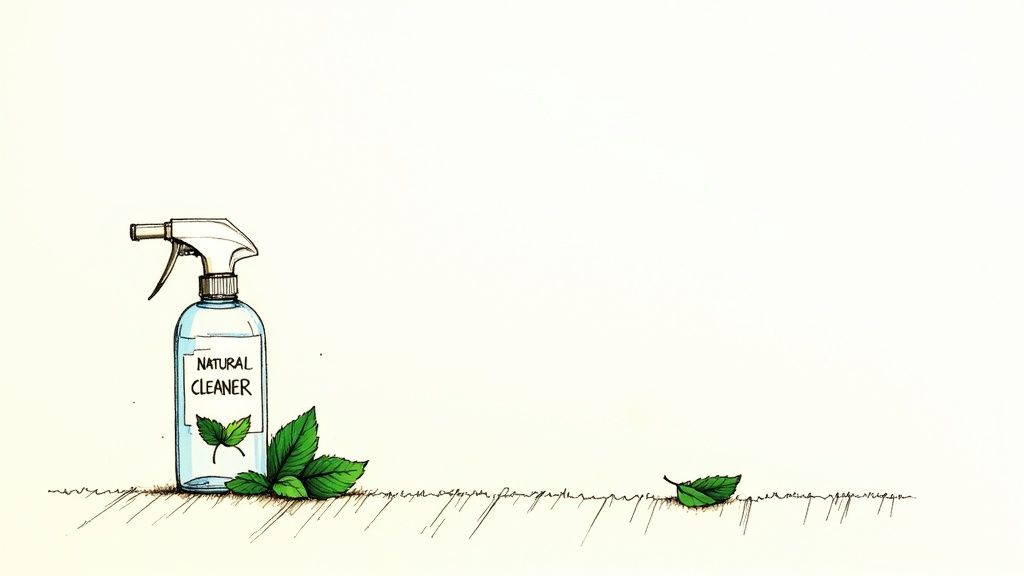
Its fine, gentle abrasive texture lifts trapped grime without harming fibres. When you sprinkle it on a patch, let it sit, then vacuum, the results speak for themselves.
Then add white vinegar, a mild disinfectant that breaks down stains and banishes musty smells. Together, they form a dynamic duo that cleans deeply, keeps costs low and protects your family from harsh chemical exposure.
“Swapping harsh chemicals for simple kitchen staples has been a game-changer in my home. It’s not just about clean carpets; it’s about peace of mind.”
The Natural Ingredients You'll Need
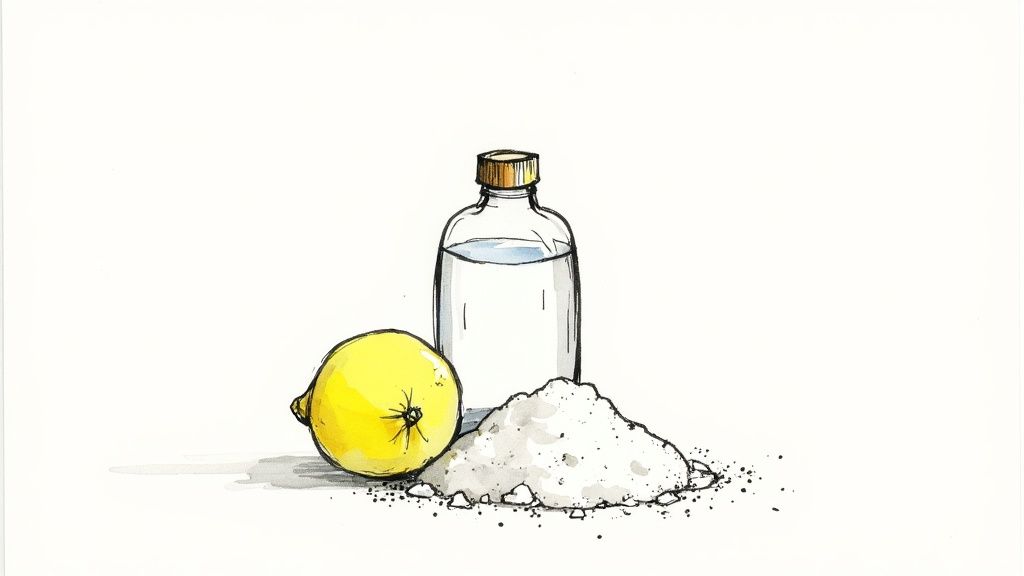
The brilliant thing about deep-cleaning your carpets naturally is that you don't need a specialist shop. A quick look in your kitchen cupboards will probably uncover everything required. The real secret isn't in finding exotic ingredients, but in understanding how these everyday items work their magic.
Let’s start with distilled white vinegar. Its gentle acidity is a powerhouse, effortlessly cutting through grime and neutralising those stubborn alkaline odours – think pet smells or spilt milk. Just be sure to grab the clear white vinegar; the darker apple cider or malt varieties can leave a stain.
Then, there's baking soda (or bicarbonate of soda). This is your go-to deodoriser. The fine particles are incredibly effective at latching onto and absorbing bad smells, pulling them right out of the fibres. For best results, always use a fresh box. The one that's been sitting in your fridge has already been working hard absorbing food smells and won't be nearly as effective on your carpet.
The Right Tools for the Job
Of course, having the right ingredients is only half the battle. A few simple tools will make the entire process smoother and much more effective. No need for expensive gadgets here.
- A decent spray bottle: This is key for applying your cleaning solution evenly. You want to dampen the carpet, not soak it, as too much moisture can lead to mildew problems.
- A stiff-bristled brush: You'll need this to work the cleaning solution deep into the pile, getting right down to the base where dirt hides. A bit of elbow grease here goes a long way.
- Clean, white microfibre cloths: Always use white cloths for blotting. Coloured ones can sometimes bleed dye onto your carpet when wet, which is the last thing you want.
And for a finishing touch? A few drops of essential oil can make a real difference. Tea tree oil has fantastic natural antibacterial properties, while something like lavender or lemon leaves a beautiful, clean fragrance behind, without any of the harsh chemicals found in commercial air fresheners.
Here's a quick-reference table to help you gather your supplies. Think of this as your recipe for a cleaner, fresher carpet.
Your Natural Carpet Cleaning Shopping List
| Ingredient/Tool | Primary Use | Pro Tip |
|---|---|---|
| Baking Soda | Deodorising and lifting dirt | Use a fresh, unopened box for maximum odour absorption. |
| White Vinegar | Stain removal and odour neutralising | Dilute 50/50 with water in your spray bottle for a general-purpose cleaner. |
| Spray Bottle | Even application of liquid solutions | Look for one with an adjustable nozzle to switch between a mist and a stream. |
| Stiff-Bristled Brush | Agitating carpet fibres | A small, handheld brush gives you better control for working on specific stains. |
| Microfibre Cloths | Blotting and drying | Always use white cloths to avoid any risk of colour transfer. |
| Essential Oils | Adding fragrance and antibacterial properties | Just 5-10 drops of tea tree or lavender oil per spray bottle is plenty. |
With these items at the ready, you’re all set to tackle even the most stubborn carpet grime.
My Top Tip: Before you go all-in on your living room carpet, always do a quick spot test. Find a hidden area – under the sofa or inside a cupboard – and apply a small amount of your cleaner. Let it dry to make sure it doesn’t affect the colour. Better safe than sorry
Deep Cleaning Your Carpets Naturally
Right, let's get those carpets looking their best. Before you even think about mixing up a cleaning solution, the single most important thing you can do is give the carpet a really thorough vacuum. I can't stress this enough. If you skip this, you're just going to turn all that loose dust and grit into a muddy mess.
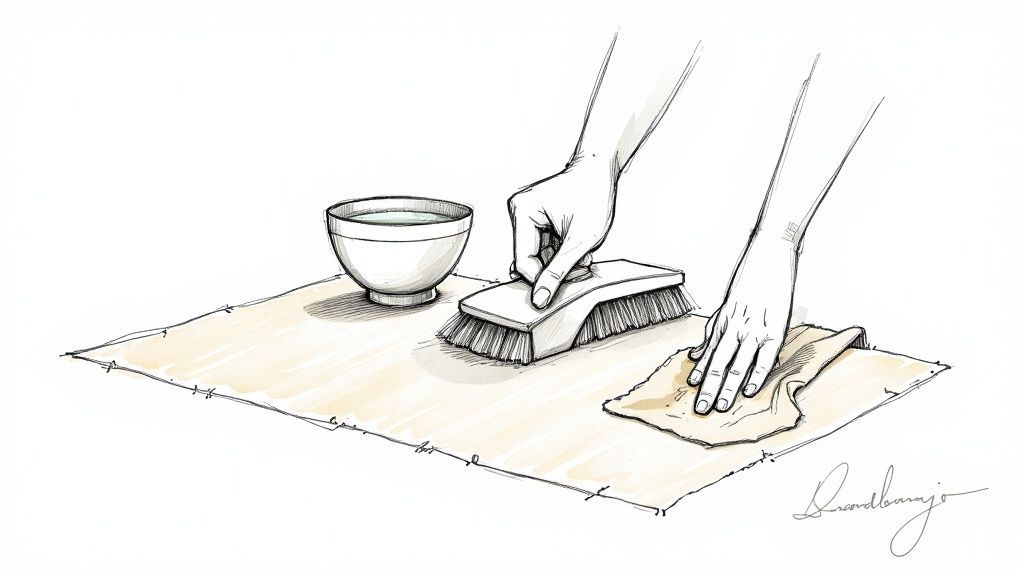
Go over the entire carpet slowly, making several passes. And here’s a pro tip: change direction. Vacuum north-to-south, then east-to-west. This lifts the pile from different angles and pulls out so much more hidden dirt. Honestly, this prep work is what separates a good result from a great one.
It's no surprise that people are looking for greener cleaning methods. We're all more aware of indoor air quality, and carpets can be magnets for allergens. This shift has boosted the UK cleaning industry, which contributed a massive £59.8 billion to the economy back in 2021. If you're curious about the numbers, you can discover more UK cleaning industry statistics on policybee.co.uk and see just how big this trend is.
Mixing And Applying Your Solution
Now for the magic potion. This is my go-to recipe for a general-purpose deep clean that won’t leave behind any sticky, dirt-attracting residue.
Your All-Purpose Cleaning Mix:
- Grab a spray bottle and mix one part distilled white vinegar with one part warm water.
- Add about half a teaspoon of a simple, natural, unscented washing-up liquid.
- For a lovely fresh scent, throw in 5-10 drops of lavender or tea tree essential oil.
Give the bottle a gentle swirl to mix everything together. The trick now is in the application. Work in small, manageable sections and lightly mist the carpet. You're aiming to make the fibres damp, not soak the padding underneath. This is a classic mistake that can lead to musty smells or even mildew.
One of the biggest errors I see is people drenching their carpets, thinking more solution equals a better clean. It doesn't. A light, even mist is far more effective and stops moisture from getting trapped deep down in the underlay.
Letting It Work And Finishing Up
Once you’ve sprayed an area, walk away. Let the solution sit for at least 15-20 minutes. This ‘dwell time’ is where the real work happens. It gives the vinegar the time it needs to break down the grime and loosen it from the carpet fibres.
After it's had a chance to work, grab a clean, dry, white microfibre cloth. Don’t rub! Just press it firmly into the carpet to blot up the moisture, which will pull the dissolved dirt out with it. Keep moving to a clean part of the cloth (or grab a fresh one) as you work your way across the area.
Finally, the carpet needs to air dry completely. This can take a few hours, so be patient. You can speed things up by opening a few windows or setting up a fan. The result is a genuinely clean carpet that feels fresh and is free from harsh chemical residue. Of course, if this all sounds like too much elbow grease, you can always explore professional cleaning services for your home.
How to Tackle Tough Stains Naturally
A good deep clean is brilliant for keeping your carpets fresh, but let's be realistic – spills happen. That heart-stopping moment when a glass of red wine topples over or the dog tracks in mud can feel like a disaster. But before you reach for a harsh chemical cleaner, take a look in your kitchen cupboards.
The trick is to act fast and use the right natural remedy for the job. Different messes need different solutions. What works for a greasy food stain won't necessarily touch a coffee spill, so a little know-how goes a long way.
Specific Recipes for Common Spills
For oily or greasy marks from things like pizza or salad dressing, water is your enemy; it will just make the stain spread. Instead, your first line of defence is cornstarch or baking soda.
Cover the greasy spot generously with the powder and leave it to work its magic for at least 15-20 minutes. You'll see it start to absorb the oil right out of the fibres. Once it's had time to sit, just vacuum it all up. It's amazing how much of the grease it lifts out.
For that classic red wine emergency, the key is salt. First, carefully blot the spill with a clean, dry cloth – don't rub! Your goal is to soak up as much of the wine as you can. Then, mix up a thick paste with regular table salt and a little cool water. Slather this paste over the stain and let it dry completely. As it hardens, the salt pulls the wine pigment out of the carpet. Once it's fully dry, you can break up the crust and vacuum it away.
If you're still left with a faint mark after trying these methods, our guide on how to remove stubborn stains has a few more tricks up its sleeve.
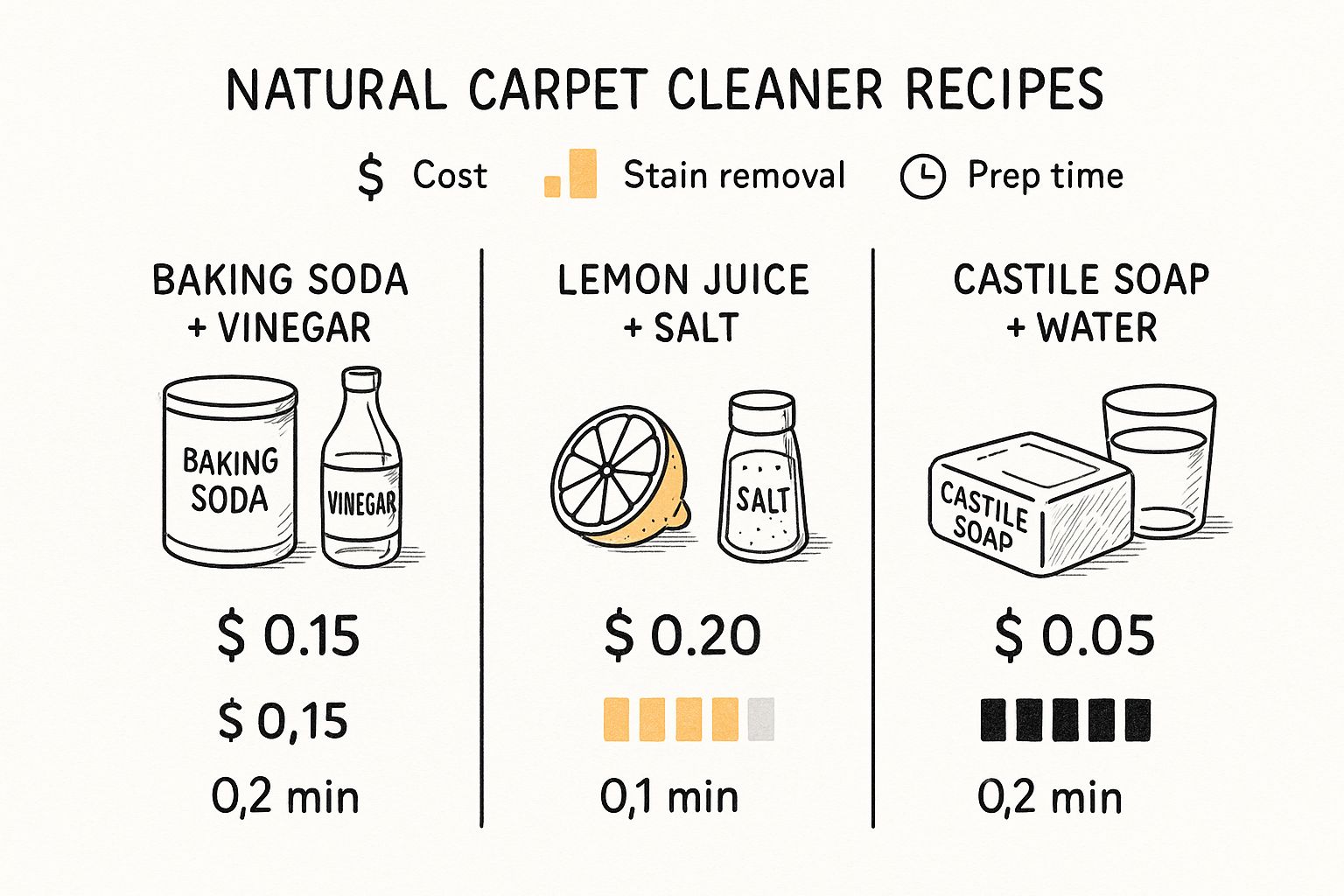
As you can see, a simple solution like baking soda and vinegar often provides the best mix of low cost and high effectiveness for everyday cleaning jobs.
Why These Natural Methods Actually Work
It's not just old wives' tales; there's real science behind these remedies. Cornstarch is incredibly absorbent, which is why it's so good at soaking up oily liquids from porous materials like carpet fibres. The salt paste works through osmosis, essentially drawing the liquid (and the red wine pigment with it) up and out of the carpet.
Knowing the 'why' makes it easier to tackle stains with confidence.
The Golden Rule of Stain Removal: Always blot, never rub. Rubbing only grinds the stain deeper into the carpet and can damage the fibres, leaving a fuzzy, worn-out patch. Gentle blotting is always the right move.
Natural Solutions for Common Carpet Stains
To make things even easier, here's a quick reference table for some of the most common household spills and the best natural approach for each one.
| Stain Type | Recommended Natural Recipe | Application Method |
|---|---|---|
| Coffee or Tea | Equal parts white vinegar and water | Lightly spritz the solution onto the stain, let it sit for 15 minutes, then blot with a clean, damp cloth until the stain lifts. |
| Mud | Let it dry completely! | Once the mud is hard, break up the large pieces and vacuum thoroughly. Treat any remaining discolouration with a mild vinegar and water solution. |
| Pet Urine | 1 cup water, 1 cup white vinegar, 2 tsp baking soda | Blot up as much liquid as possible. Spray the solution, let it fizz and sit for 10-15 minutes, then blot dry. The vinegar neutralises the ammonia. |
| Grease or Oil | Cornstarch or baking soda | Liberally sprinkle powder on the stain, let it absorb the grease for at least 20 minutes, then vacuum it all up. |
| Red Wine | A thick paste of salt and cool water | After blotting the spill, apply the salt paste, let it dry completely, then break it up and vacuum away the residue. |
These simple, targeted approaches prove you don't always need a cupboard full of expensive, specialised cleaners to keep your carpets looking their best.
Keeping Your Carpet Fresh and Clean
Giving your carpet a really good deep clean is satisfying, but the real secret to a lovely home is keeping it that way. It all comes down to building a few simple habits that stop your carpets from looking tired between those big cleaning days.
A quick weekly refresh can work wonders. I often recommend mixing a cup of bicarbonate of soda with 10-15 drops of an essential oil you love – lavender or lemon are always great choices. Just give it a light sprinkle over the carpet, leave it for 15 minutes to soak up any musty smells, and then vacuum it all up. Simple.
Little Habits, Big Impact
Honestly, preventing the dirt from getting onto your carpet in the first place is half the battle won. Placing a decent doormat at every entrance makes a massive difference to the amount of mud and grit that gets tracked through the house.
If you can get everyone on board, a "no shoes inside" rule is another game-changer. It protects the carpet fibres from getting ground down and just keeps everything so much cleaner.
This focus on proactive home care is definitely growing. It’s no surprise that the UK's carpet cleaner market was valued at an estimated USD 968.40 million in 2024. People are clearly looking for practical, effective ways to keep their homes hygienic, and using natural methods for day-to-day upkeep fits right in. You can see a full breakdown of the carpet cleaner market trends on cognitivemarketresearch.com.
Remember, a little and often is far better than a massive effort every few months. A five-minute refresh each week will do more for your carpet's look and feel than a huge clean twice a year. It's about finding a routine that works for you.
Got Questions About Natural Carpet Cleaning? We’ve Got Answers
It's only natural to have a few questions before you start scrubbing your floors with ingredients from your kitchen cupboard. People often wonder if these natural solutions are genuinely up to the job or if they might accidentally damage their beloved carpet. Let's clear up some of those common worries.
Is Vinegar Really Safe for My Carpet?
For most synthetic carpets—think nylon or polyester—white vinegar is a brilliant, streak-free cleaner. But, and this is a big but, it's not a one-size-fits-all solution. Its acidic nature can be a real problem for natural fibres like wool or silk, leading to permanent damage or faded colour.
I can't stress this enough: always do a patch test. Find an out-of-the-way spot, maybe in a wardrobe or under the sofa, dab on a little of your diluted vinegar solution, and wait for it to dry completely. It’s a simple step that can save you a world of heartache.
How Long Until I Can Walk on It Again?
Drying time can be anywhere from 4 to 12 hours. It all comes down to a few key things: the pile depth of your carpet, the humidity in your home, and how much air you can get moving through the room.
Want to speed things up?
- Go easy on the cleaning solution; a light, even application is all you need.
- Crack open some windows to get a good cross-breeze going.
- Point a fan at the damp area or switch on a dehumidifier to pull the moisture right out of the air.
Can I Put My Homemade Cleaner in a Rental Machine?
This is where you need to be careful. While a simple baking soda and water mix is usually okay, vinegar is a different story. The acidity can eat away at the metal components inside some cleaning machines over the years.
Before you even think about it, read the machine’s user manual. Using a homemade natural carpet cleaner might not just cause damage; it could also void the warranty. For more professional tips and tricks, feel free to browse the other articles on the Signal Cleaning blog.
When in doubt, a little caution goes a long way. Taking a minute to do a quick patch test or check your machine’s manual is the best way to avoid costly mistakes and get the fresh, clean carpets you're after.
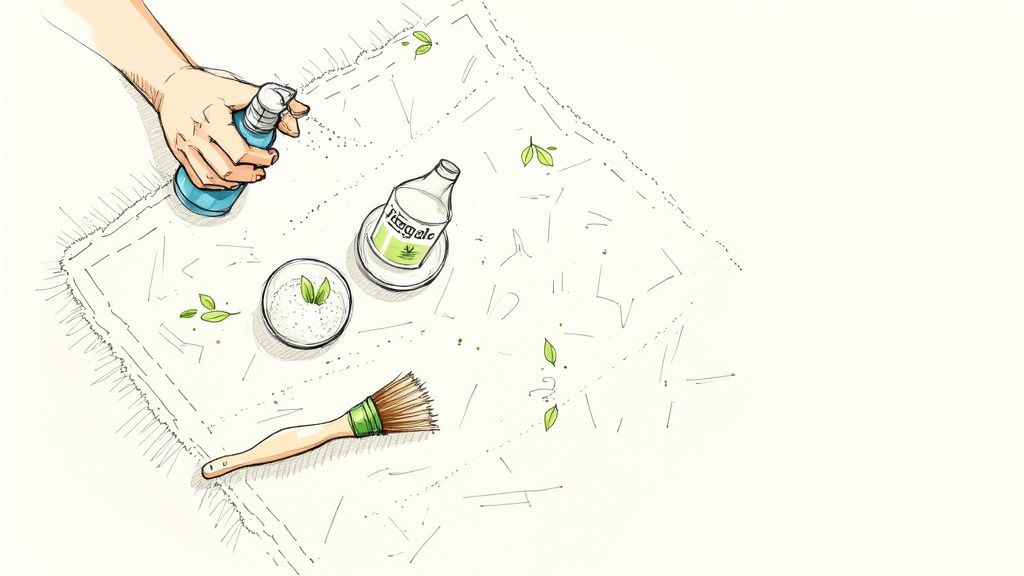
Leave a Reply